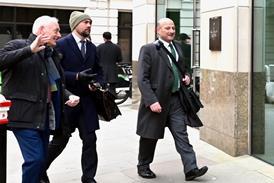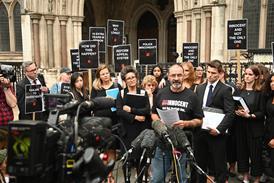Building a profession
IN THE FIRST INSTALMENT OF A FOUR-PART SERIES CHRONICLING THE DEVELOPMENT OF THE PROFESSION, ELIZABETH CRUICKSHANK LOOKS AT THE MOMENTOUS EVENTS THAT OCCURRED BETWEEN 1903 AND 1928
At the beginning of the 20th century, the population of England and Wales was 32.5 million.
There were 16,000 practising solicitors.
The present population of 52 million requires almost 90,000 practising solicitors.
It was estimated that the practising bar a century ago consisted of between 660 and 1,450 barristers out of a total of 4,000 who had been called.
Although the numbers, working circumstances and social origins of lawyers in the first quarter of the last century differed considerably from their 21st century equivalents, their concerns were surprisingly similar.
Money as always was a topic of importance.
An overcrowded profession
Money, or the lack of it, restricted entry to the law in 1903.
Articled clerks were required to pay premiums to their training principals of several hundred pounds, stamp duty of 80 on articles (at a time when average industrial earnings were 60 a year), received no salary during articles of up to five years' duration, and once qualified were subject to annual certificate duty of 6 to 9.
To put this further in context, Harold Kay of Blackpool, a solicitor's clerk, managed to save 120 from his Army pay during the First World War so that he could enter into articles on his return; 80 of that went in stamp duty.
The Law Society, first legally constituted as the Law Institution in 1825, accepted the high rates of stamp duty on articles after 1870 as one way of limiting entrance to a profession regarded by many as overcrowded, and instituted examinations in 1836 in an attempt to prevent unqualified people from holding themselves out as attorneys.
The Solicitors Act 1860 further refined the system into a preliminary examination including Latin before articles, an intermediate examination half-way through articles and a finals examination on completion of articles.
Otherwise, Society supervision was rudimentary.
Writing in the Gazette in 1960, Francis Pitt-Rivers, admitted in 1912, commented that, 'so long as one's principal was content to take one, nobody else bothered much about it, and the articled clerk had little or no contact with the Law Society beyond making sure that his articles were duly registered'.
But gradually the Society's attitude became more rigorous and the Solicitors Act 1922 made the attendance of articled clerks (now trainee solicitors) at a recognised law school compulsory for one year on a part-time basis with exemption for 'ten-year men' (managing clerks with ten years' service).
The solicitor's office and staff
Despite the availability of typewriters, conveyances in the early decades of the 20th century were still laboriously drafted in a good copperplate hand, and not until 1919 did the Society draw its members' attention to the convenience of sending carbon copies of drafts to other solicitors.
The amount of legislation was not large, case reports tended to be short and pithy, and a legal library of 20 books was perceived as adequate.
Office hours were long.
Most offices, particularly in London, opened from 9am to 8pm.
Saturday opening was universal, and one provincial solicitor required his staff to attend after church on Sundays if required.
After the First World War, rules were made at one office restricting cigarette smoking to 'after the four o'clock tea'.
In 1903, female secretaries were still a novelty, and with probably slightly more than 100 female clerks in solicitors' offices; non-legally qualified staff were predominantly male clerks who might over time gradually acquire many of the skills of a solicitor without the commensurate risk and reward.
It is easy to be confused about the status of solicitors' managing clerks.
Although legally permitted to set up in practice on their own account immediately on qualification, it was common for newly qualified solicitors to take positions as 'admitted managing clerks' for a few years.
Their progress from this position would depend on their being able to raise the substantial capital required to set up their own offices or to purchase partnerships (at usually three times net annual profits).
'Unadmitted clerks' were hired often as young as 13 years old to run errands and copy documents, and left to pick up legal expertise on their own.
Experienced managing clerks, on the other hand, were a valuable resource, who could command salaries of 100 to 150 a year.
In keeping with the general movement towards trade unions, law clerks set up their own societies from the 1890s onwards.
In 1919, the National Federation of Law Clerks voted for professional competence to be validated by educational tests and for a minimum salary of 400 a year.
This latter demand was refused by solicitors, who more importantly supported the incorporation of the Solicitors Managing Clerks Society in 1928.
This transformed into the Institute of Legal Executives in 1963.
Taking control
In 1913, the Master of the Rolls recognised 'the increased confidence placed in the solicitors at the present day...
due in no small measure to the efforts of the various law societies to raise the standard of legal education'.
By the successive Solicitors Acts of 1888, 1910 and 1919, the Society's discipline committee, appointed by the Lord Chancellor from present and former members of the Society's Council, was given the right to determine complaints against solicitors, to suspend them and to remove their names from the Roll.
The dual process of examination and policing had gradually changed the public's perception of solicitors as part of a motley crew of process servers and pleaders.
Instead, they were seen as a profession to be regarded with confidence, if not always with affection.
The Society had supported the Larceny Act 1901, which made the misappropriation of client funds a criminal offence, and the penalties for defalcation now included imprisonment with hard labour.
In 1912, one solicitor was sentenced to four years' penal servitude for misappropriation even though he had made good all the money that he took from client account.
But despite this salutary spectacle, few solicitors wanted compulsory auditing of their often haphazard book-keeping.
Earning power
During the Edwardian period, it was possible to run a family home in Bristol with two maids on 700 a year, have two months' holiday abroad and still save 200 a year.
But the reality was that a quarter of solicitors had incomes of less than 185, half were earning 390 a year or less and 20% of all solicitors were managing clerks earning the same or less as experienced unadmitted men.
Some astute solicitors were able to enhance their incomes from legal work through shrewd investment, such as the Newcastle solicitor whose investments in the new railway system resulted in an estate with a probate value of 728,000.
The bar's financial spectrum was similarly varied.
In 1910, famed advocate Edward Marshall Hall commented that there were 1,500 men at the bar, with only enough work for 1,000, and that that work was performed by 500.
Alongside the majority attracting minimal fees, a handful of practising barristers had fee income of 10,000 to 15,000 a year, and the four Lords of Appeal in Ordinary were each paid 6,000.
The bar
Until 1872, a young man could become a barrister without taking any examinations at all, and firm requirements for call were not set out until 1910.
A student was to be at least 21 years old, attend for 12 terms at his Inn and pass public written examinations acceptable to the Council of Legal Education, established in 1852, before he could be called.
However, it is questionable how competent new barristers felt before beginning their practice - reading under a practising barrister (for a standard pupillage fee of 100 guineas) for at least six months before being called was only recommended, not required.
The bar's flexible education requirements probably resulted from its relatively low numbers and the recognition that being a barrister was as much a social as a professional qualification, providing an entry into a variety of occupations.
Traditionally, from the ranks of the nobility and gentry, many barristers - particularly those from families with parliamentary seats at their disposal - went to the bar as a preliminary to entering the House of Commons.
The bar thus acquired an effective parliamentary lobby against any proposed limitations on restrictive practices.
Aftermath of war
The First World War deprived the legal profession of many men, both temporarily and permanently.
Some 3,500 solicitors and 1,500 articled clerks served in the armed forces and of those, 565 solicitors and 341 articled clerks were killed.
The profession provided a book of remembrance, and its pages are still turned daily in the Society reading room.
At the end of the war, there were 3,000 fewer solicitors on the Roll than there had been at the beginning, and both the Society and Bar Council asked their members to train suitably qualified young men who had served in the war without payment of either premiums or pupillage fees.
And somewhat strangely for an organisation which had promoted constant improvement of professional standards, the Society supported the Solicitors (Articled Clerks) Act 1918, which permitted articled clerks to count time spent in the forces as good service for the purpose of articles.
Admission of women
The Benchers of Gray's Inn refused in 1903 to admit Bertha Cave as a bar student, and in 1913 four female university graduates took the Society to court for refusing them permission to register for its examinations.
The Court of Appeal's decision in Bebb v Law Society [1914] 1 Ch 286 supported the governing body, relying heavily on the authority of a mediaeval treatise which laid down that 'all who are not prohibited by law may be attorneys but the law will not suffer women to be attorneys nor infants nor serfs'.
It was only the government's post-war concern with 'reconstruction' which produced time for parliamentary Bills supporting women's rights to enter the professions.
Male solicitors were confused as to why women should be admitted (was it a 'reward' for their war work, or was it on the basis of equality?) and the consequences of admission - would women flood the profession, or would they fail because they lacked the requisite qualities?
However, satisfied that young men returning from the war would not feel disadvantaged, the Society opined in 1919 that 'in view of the present economic and political position of women, it is in the opinion of this meeting expedient that the existing obstacles to their entry to the legal profession should be removed'.
The resulting Sex (Disqualification) Removal Act 1919 permitted women to hold any office or to enter or carry on any civil profession or vocation, and the Society duly registered the articles of 12 young women.
In 1922, Helena Normanton thus became the first woman to practise as a barrister and Carrie Morrison the first woman to qualify as a solicitor of the Supreme Court of England and Wales.
The ministry of justice
The government's concern with reconstruction resulted in proposals for an amalgamation of the two branches of the legal profession and also for a minister of justice; these were to some extent related.
The machinery of government committee, set up to promulgate greater administrative efficiency, proposed that a minister of justice might take over some of the responsibilities of the Lord Chancellor, particularly those concerned with the administration of the services connected with justice and the prisons.
This was seen as being dependent on the fusion of the two branches of the profession.
Some solicitors were concerned that fusion was merely a necessary preliminary to increased governmental control over the profession, although the touted benefits were that barristers could lessen the financial insecurity of their early professional years by practising first as solicitors, whose income was considered more consistent.
They could then transfer to the bar without having to start their careers afresh.
In the end, both sides concluded that they were fundamentally different in terms of traditions, purpose and even physical location - the bar being concentrated in cities whereas solicitors were scattered throughout the country.
The profession rejected fusion and the ministry did not materialise.
New property laws
Property transactions traditionally provided a consistent source of income.
The scale charge system put in place by the Solicitors Remuneration Act 1881 meant that in 1910, a house worth 380 attracted conveyancing fees at 3% of its value, a sum more in line with present-day estate agents' fees than those of solicitors.
But admitting in its 1922 annual report that 'the present system of transfer by deed is out of date, cumbersome and expensive', the Society - after extracting several amendments - supported the Law of Property Act 1925, which came into force on 1 January 1926.
This provided for a ten-year period during which the old system and the system of registration and transfer on the register would run in tandem.
Registration applied only in designated areas and was not to be extended to other parts of the country until the end of the probationary period, and then only after public inquiries called by the affected county councils.
The Society was perhaps more persuaded that the profession would accept the raft of new legislation, because it had successfully recommended that solicitors should have remuneration at a rate that ensured solicitors could still make money from dealing with land.
Momentous events were around the corner for the legal profession as it came to the end of the roaring 20s.
The next 25 years would see the faltering steps of what became the legal aid system, the devastation of the Second World War and the beginning of the end of the profession's Victorian practices.
- We would like to thank Catherine Pease in the Law Society library for her help with illustrating this feature, and Linklaters and Gregory Rowcliffe Milners for providing archive photographs.
- The next instalment will be published on 24 July.
Elizabeth Cruickshank is a solicitor and author of Women in the Law, which will be published by the Law Society in the autumn


























No comments yet